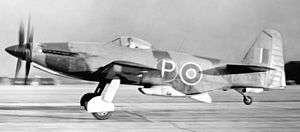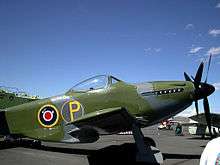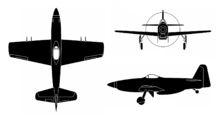Martin-Baker MB 5
| MB 5 | |
|---|---|
 | |
| Role | Fighter |
| National origin | United Kingdom |
| Manufacturer | Martin-Baker |
| First flight | 23 May 1944 |
| Status | Experimental |
| Primary user | Royal Air Force (intended) |
| Number built | 1 |
| Developed from | Martin-Baker MB 3 |
The British Martin-Baker MB 5 was the ultimate development of a series of prototype fighter aircraft built during the Second World War. Neither the MB 5 nor its predecessors ever entered production, despite what test pilots described as excellent performance.[1]
Design and development
Martin-Baker Aircraft actually began the MB 5 as the second Martin-Baker MB 3 prototype, designed to Air Ministry Specification F.18/39 for an agile, sturdy Royal Air Force fighter, able to fly faster than 400 mph. After the first MB 3 crashed in 1942, killing Val Baker, the second prototype was delayed. A modified MB 3 with a Rolls-Royce Griffon was planned as the MB 4, but a full redesign was chosen instead.[2]
The re-designed aircraft, designated MB 5, used wings similar to the MB 3, but had an entirely new steel-tube fuselage. Power came from a Rolls-Royce Griffon 83 liquid-cooled V-12 engine, producing 2,340 hp (1,745 kW) and driving two three-bladed contra-rotating propellers.[3] Armament was four 20 mm Hispano cannon, mounted in the wings outboard of the widely spaced retractable undercarriage. A key feature of the design was ease of manufacture and maintenance: much of the structure was box-like, favouring straight lines and simple conformation.[4]
It was built under the same contract that covered the building of the MB.3.[5]
Flight testing
The first flight of the MB 5 prototype, serial R2496, took place on 23 May 1944.[6] Performance was considered outstanding by test pilots, and the cockpit layout was praised by the Aeroplane and Armament Experimental Establishment (A&AEE). The accessibility of the fuselage for maintenance was excellent, thanks to a system of detachable panels.
- "In my opinion this is an outstanding aircraft, particularly when regarded in the light of the fact that it made its maiden flight as early as 23rd May 1944"
– Test pilot Capt. Eric Brown, 1948 [1]
Acknowledged as one of the best aerobatic pilots in the UK, S/L Janusz Żurakowski from the A&AEE at RAF Boscombe Down gave a spectacular display at the Farnborough Air Show in June 1946, with the Martin-Baker MB 5, a design he considered as a superlative piston-engined fighter, better in many ways than the Spitfire.

Serial production, had it been authorised, would have begun in time for squadron service over Germany. Instead, the RAF directed their attention towards jet-powered fighters and the MB 5 remained unordered. Perhaps one of the reasons that the MB 5 did not go into production, was because the Rolls-Royce Griffon engine failed when the MB 5 was being demonstrated to Prime Minister, Sir Winston Churchill, the Chief of the Air Staff and a host of other VIPs at an important display of British and captured German aircraft at Farnborough.[7] Another reason, stated by Michael Bowyer, is that Martin-Baker may have lacked both facilities and sufficient government support.[8] The company's slow progress with the machine could have been due to a lack of facilities.[5]
The original MB 5 was reputedly destroyed on a gunnery range . Martin-Baker went on to become one of the world's leading builders of ejection seats.
Replica construction
A partial replica is being built in Reno, Nevada, USA by John Marlin using wings from a P-51 Mustang.[9] The website stated in 2006 that it was nearing completion, and as of 2010, an undated entry shows a photograph of the aircraft taxiing and says that it is nearing completion.
Specifications (MB 5, as designed)

Data from Jane’s Fighting Aircraft of World War II[6] and British Aircraft of World War II[10]
General characteristics
- Crew: one
- Length: 37 ft 9 in (11.5 m)
- Wingspan: 35 ft 0 in (10.7 m)
- Height: 15 ft 0 in (4.5 m)
- Wing area: 262 ft² (24.3 m²)
- Empty weight: 9,233 lb (4,188 kg)
- Loaded weight: 11,500 lb (5,216 kg)
- Max. takeoff weight: 12,090 lb (5,484 kg)
- Powerplant: 1 × Rolls-Royce Griffon 83 liquid-cooled V-12 engine, 2,340 hp (1,745 kW)
Performance
- Maximum speed: 460 mph (740 km/h) at 20,000 ft (6,100 m)
- Range: 1,100 mi (1,770 km)
- Service ceiling: 40,000 ft (12,190 m)
- Rate of climb: 3,800 ft/min (19.3 m/s)
Armament
- Guns: 4× 20 mm Hispano Mk.II cannon
See also
- Related development
- Aircraft of comparable role, configuration and era
- Related lists
References
- Notes
- 1 2 Brown 1983, pp. 150–153.
- ↑ Baugher, Joe. "Martin-Baker MB 5." Aircraft of the World, 19 November 1995. Retrieved: 9 April 2006.
- ↑ MB 5 Martin-Baker History. Retrieved: 9 April 2006.
- ↑ 'Sir James Martin' Sarah Sharman ISBN 1 85260 551 0
- 1 2 Buttler 2004, p. 31.
- 1 2 Jane 1946, pp. 129–130.
- ↑ Donald 1997, pp. 150–157.
- ↑ Bowyer 1984, pp. 124–125.
- ↑ Marlin, Paul D. "John's First Flying Adventures." John Marlin's MB5 replica website (johnmarlinsmb5replica.mysite.com). Retrieved: 5 May 2010.
- ↑ Teeuwen, Jaap. "Martin-Baker MB 5". British Aircraft of World War II. Retrieved: 9 April 2006.
- Bibliography
- Bowyer, Michael J.F. Interceptor Fighters for the Royal Air Force 1935–45. Wellingborough, UK: Patrick Stephens Ltd., 1984. ISBN 0-85059-726-9.
- Buttler, Tony. Secret Projects: British Fighters and Bombers 1935–1950 (British Secret Projects 3). Leicester, UK: Midland Publishing, 2004. ISBN 1-85780-179-2.
- Brown, Captain Eric. Wings of the Weird & Wonderful, Volume 1. London: Airlife, 1983. ISBN 0-906393-30-2.
- Donald, David. "Martin-Baker Fighters." Wings of Fame, Vol. 9, 1997, Aerospace Publishing Ltd., ISSN 1361-2034.
- Green, William, ed. "Mr. Martin's Memorable M.B.5." Air International Vol. 16, no. 2, February 1979.
- Green, William. War Planes of the Second World War: Fighters, Volume Two. London, Macdonald & Co. (Publishers) Ltd., 1961.
- Green, William and Swanborough, Gordon. WW2 Fact Files: RAF Fighters, Part 2. London: Macdonald and Jane's Publishers Ltd., 1979. ISBN 0-354-01234-7.
- Jane, Fred T. "The Martin-Baker F.18/39." Jane’s Fighting Aircraft of World War II. London: Studio, 1946. ISBN 1-85170-493-0.
- Zuk, Bill. Janusz Zurakowski: Legends in the Sky. St. Catharine's, Ontario: Vanwell, 2004. ISBN 1-55125-083-7.
External links
| Wikimedia Commons has media related to Martin-Baker M.B.5. |